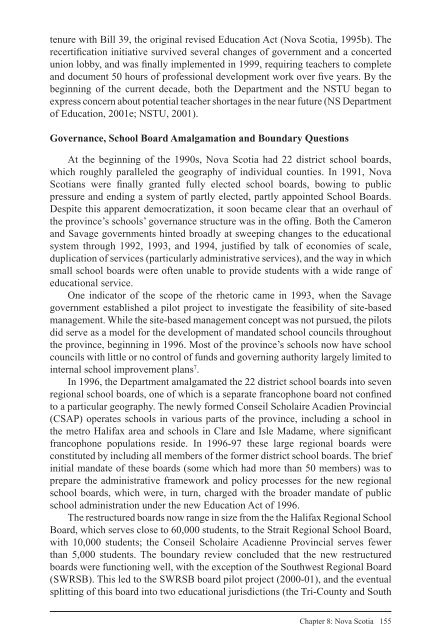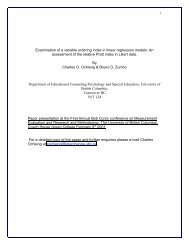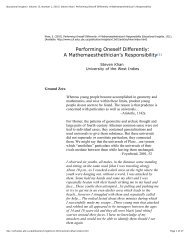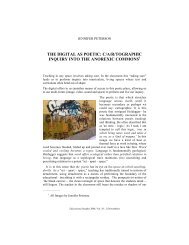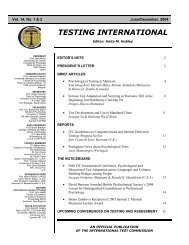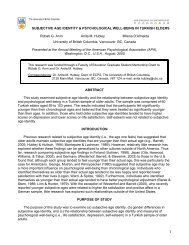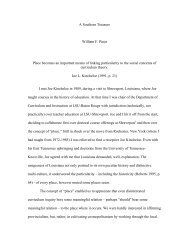The evolution of professionalism - Centre for Policy Studies in ...
The evolution of professionalism - Centre for Policy Studies in ...
The evolution of professionalism - Centre for Policy Studies in ...
Create successful ePaper yourself
Turn your PDF publications into a flip-book with our unique Google optimized e-Paper software.
tenure with Bill 39, the orig<strong>in</strong>al revised Education Act (Nova Scotia, 1995b). <strong>The</strong><br />
recertifi cation <strong>in</strong>itiative survived several changes <strong>of</strong> government and a concerted<br />
union lobby, and was fi nally implemented <strong>in</strong> 1999, requir<strong>in</strong>g teachers to complete<br />
and document 50 hours <strong>of</strong> pr<strong>of</strong>essional development work over fi ve years. By the<br />
beg<strong>in</strong>n<strong>in</strong>g <strong>of</strong> the current decade, both the Department and the NSTU began to<br />
express concern about potential teacher shortages <strong>in</strong> the near future (NS Department<br />
<strong>of</strong> Education, 2001e; NSTU, 2001).<br />
Governance, School Board Amalgamation and Boundary Questions<br />
At the beg<strong>in</strong>n<strong>in</strong>g <strong>of</strong> the 1990s, Nova Scotia had 22 district school boards,<br />
which roughly paralleled the geography <strong>of</strong> <strong>in</strong>dividual counties. In 1991, Nova<br />
Scotians were fi nally granted fully elected school boards, bow<strong>in</strong>g to public<br />
pressure and end<strong>in</strong>g a system <strong>of</strong> partly elected, partly appo<strong>in</strong>ted School Boards.<br />
Despite this apparent democratization, it soon became clear that an overhaul <strong>of</strong><br />
the prov<strong>in</strong>ce’s schools’ governance structure was <strong>in</strong> the <strong>of</strong>fi ng. Both the Cameron<br />
and Savage governments h<strong>in</strong>ted broadly at sweep<strong>in</strong>g changes to the educational<br />
system through 1992, 1993, and 1994, justifi ed by talk <strong>of</strong> economies <strong>of</strong> scale,<br />
duplication <strong>of</strong> services (particularly adm<strong>in</strong>istrative services), and the way <strong>in</strong> which<br />
small school boards were <strong>of</strong>ten unable to provide students with a wide range <strong>of</strong><br />
educational service.<br />
One <strong>in</strong>dicator <strong>of</strong> the scope <strong>of</strong> the rhetoric came <strong>in</strong> 1993, when the Savage<br />
government established a pilot project to <strong>in</strong>vestigate the feasibility <strong>of</strong> site-based<br />
management. While the site-based management concept was not pursued, the pilots<br />
did serve as a model <strong>for</strong> the development <strong>of</strong> mandated school councils throughout<br />
the prov<strong>in</strong>ce, beg<strong>in</strong>n<strong>in</strong>g <strong>in</strong> 1996. Most <strong>of</strong> the prov<strong>in</strong>ce’s schools now have school<br />
councils with little or no control <strong>of</strong> funds and govern<strong>in</strong>g authority largely limited to<br />
<strong>in</strong>ternal school improvement plans 7 .<br />
In 1996, the Department amalgamated the 22 district school boards <strong>in</strong>to seven<br />
regional school boards, one <strong>of</strong> which is a separate francophone board not confi ned<br />
to a particular geography. <strong>The</strong> newly <strong>for</strong>med Conseil Scholaire Acadien Prov<strong>in</strong>cial<br />
(CSAP) operates schools <strong>in</strong> various parts <strong>of</strong> the prov<strong>in</strong>ce, <strong>in</strong>clud<strong>in</strong>g a school <strong>in</strong><br />
the metro Halifax area and schools <strong>in</strong> Clare and Isle Madame, where signifi cant<br />
francophone populations reside. In 1996-97 these large regional boards were<br />
constituted by <strong>in</strong>clud<strong>in</strong>g all members <strong>of</strong> the <strong>for</strong>mer district school boards. <strong>The</strong> brief<br />
<strong>in</strong>itial mandate <strong>of</strong> these boards (some which had more than 50 members) was to<br />
prepare the adm<strong>in</strong>istrative framework and policy processes <strong>for</strong> the new regional<br />
school boards, which were, <strong>in</strong> turn, charged with the broader mandate <strong>of</strong> public<br />
school adm<strong>in</strong>istration under the new Education Act <strong>of</strong> 1996.<br />
<strong>The</strong> restructured boards now range <strong>in</strong> size from the the Halifax Regional School<br />
Board, which serves close to 60,000 students, to the Strait Regional School Board,<br />
with 10,000 students; the Conseil Scholaire Acadienne Prov<strong>in</strong>cial serves fewer<br />
than 5,000 students. <strong>The</strong> boundary review concluded that the new restructured<br />
boards were function<strong>in</strong>g well, with the exception <strong>of</strong> the Southwest Regional Board<br />
(SWRSB). This led to the SWRSB board pilot project (2000-01), and the eventual<br />
splitt<strong>in</strong>g <strong>of</strong> this board <strong>in</strong>to two educational jurisdictions (the Tri-County and South<br />
Chapter 8: Nova Scotia 155


